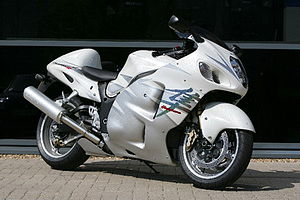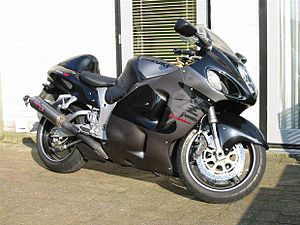Suzuki Hayabusa
 |
|
| Manufacturer | Suzuki |
|---|---|
| Also called | GSX1300R, 'Busa |
| Assembly |
Toyokawa Plant, Toyokawa, Aichi, Japan Suzuki Gurgaon Plant, Gurgaon, India |
| Class | Sport bike |
| Top speed |
1999 303–312 km/h (188–194 mph) 2000–present 299 km/h (186 mph) |
| Related | Suzuki B-King |
 |
|
| Also called | GSX-1300R-X (1999), GSX-1300R-Y (2000), GSX-1300R-K1–K7 (2001–2007) |
|---|---|
| Engine | 1,299 cc (79.3 cu in), 4-stroke inline-four, liquid-cooled, DOHC, 16-valve, Keihin/Denso fuel Injection, wet sump |
| Bore / stroke | 81.0 mm × 63.0 mm (3.19 in × 2.48 in) |
| Compression ratio | 11:1 |
| Top speed |
1999 303–312 km/h (188–194 mph) |
| Power | 173 hp (129 kW) (claimed) 113–121 kW (151.5–162.6 bhp) (rear wheel) @ 9,500–9,750 rpm, See performance and measurements |
| Torque | 126.6–135.0 N·m (93.4–99.6 lb·ft) (rear wheel)@ 6,750–7,000 rpm, See performance and measurements |
| Transmission | 6-speed, constant mesh, #532 chain drive |
| Suspension |
Front Inverted telescopic fork, fully adjustable spring preload, 14-way adjustable rebound damping and 13-way adjustable compression damping Rear Link-type, gas/oil damped, fully adjustable spring preload, 22-way adjustable compression & rebound damping |
| Brakes |
Front 6-pot Tokico calipers on 320 mm stainless steel discs Rear Single hydraulic disc |
| Tires | Bridgestone Battlax BT56 Front 120/70-ZR-17, Rear 190/50-ZR-17 |
| Rake, trail | 24.2°, 97 mm (3.8 in) |
| Wheelbase | 1,485 mm (58.5 in) |
| Dimensions |
L: 2,140 mm (84.3 in) W: 740 mm (29.1 in) H: 1,155 mm (45.5 in) |
| Seat height | 805 mm (31.7 in) |
| Weight |
See performance and measurements 215–242 kg (474–534 lb) (dry) 250–255.3 kg (551–563 lb) (wet) |
| Fuel capacity | 21 L (4.6 imp gal; 5.5 US gal) (California 19 L (4.2 imp gal; 5.0 US gal)) |
| Fuel consumption |
1999 6.4 L/100 km (37 mpg-US), 6.11 L/100 km; 46.2 mpg-imp (38.5 mpg-US) 2005 7.4 L/100 km; 38 mpg-imp (32 mpg-US) |
 |
|
| Also called | GSX-1300R-K8 (2008), -K9 (2009) |
|---|---|
| Engine | 1,340 cc (82 cu in), 4-stroke inline-four, liquid-cooled, DOHC, 16-valve, Keihin/Denso fuel Injection, wet sump |
| Bore / stroke | 81.0 mm × 65.0 mm (3.19 in × 2.56 in) |
| Compression ratio | 12.5:1 |
| Top speed | 299 km/h (186 mph) |
| Power | 197 hp (147 kW)(claimed) 172.2 bhp (128.4 kW) (rear wheel)@ 10100 rpm |
| Torque | 138.7 N·m (102.3 lb·ft),(claimed) 132.6 N·m (97.8 lb·ft) @ 7600 rpm(rear wheel) |
| Transmission | 6-speed slipper clutch, constant mesh, #530 chain drive |
| Suspension |
Front Inverted telescopic, coil spring, fully adjustable spring preload, adjustable rebound damping and adjustable compression damping Rear Link-type, gas/oil damped, fully adjustable spring preload, adjustable compression & rebound damping |
| Brakes |
Front 4-pot Tokico radial mount calipers on 310 mm x 5.5 mm disc Rear Single hydraulic disc |
| Tires | Bridgestone Battlax BT015 Front 120/70-ZR-17, Rear 190/50-ZR-17 |
| Wheelbase | 1,485 mm (58.5 in) |
| Dimensions |
L: 2,195 mm (86.4 in) W: 740 mm (29.1 in) H: 1,170 mm (46.1 in) |
| Seat height | 805 mm (31.7 in) |
| Weight |
See performance and measurements 250 kg (550 lb) (dry) 264.0–268.5 kg (582–592 lb) (wet) |
| Fuel capacity | 21 L (4.6 imp gal; 5.5 US gal) (California 20 L (5.3 US gal)) |
| Fuel consumption | 7.1 L/100 km; 40 mpg-imp (33 mpg-US) |
The Suzuki Hayabusa (or GSX1300R) is a sport bike motorcycle made by Suzuki since 1999. It immediately won acclaim as the world's fastest production motorcycle, with a top speed of 303 to 312 km/h (188 to 194 mph).
In 2000, fears of a European regulatory backlash or import ban, led to an informal agreement between the Japanese and European manufacturers to govern the top speed of their motorcycles at an arbitrary limit. The media-reported value for the speed agreement in miles per hour was consistently 186 mph, while in kilometers per hour it varied from 299 to 303 km/h, which is typical given unit conversion rounding errors. This figure may also be affected by a number of external factors, as can the power and torque values.
The conditions under which this limitation was adopted led to the 1999 Hayabusa's title remaining, at least technically, unassailable, since no subsequent model could go faster without being tampered with. Thus, after the much anticipatedKawasaki Ninja ZX-12R of 2000 fell 6 km/h (4 mph) short of claiming the title, the Hayabusa secured its place as the fastest standard production bike of the 20th century. This gives the unrestricted 1999 models even more cachet with collectors.
Besides its speed, the Hayabusa has been lauded by many reviewers for its all-round performance, in that it does not drastically compromise other qualities like handling, comfort, reliability, noise, fuel economy or price in pursuit of a single function. Jay Koblenz of Motorcycle Consumer News commented, "If you think the ability of a motorcycle to approach 190 mph or reach the quarter-mile in under 10 seconds is at best frivolous and at worst offensive, this still remains a motorcycle worthy of just consideration. The Hayabusa is Speed in all its glory. But Speed is not all the Hayabusa is."
1999 303–312 km/h (188–194 mph)
When first shown to the press in 1999, the first Hayabusas made a profound impression. No previous motorcycle has broken the production model top speed record by such a margin, 16 to 23 km/h (10 to 14 mph), depending on which measured speeds the source was relying on for the CBR1100XX and the GSX-1300R.
Hayabusa (隼?) is Japanese for "peregrine falcon", a bird that often serves as a metaphor for speed due to its vertical hunting dive, or stoop, speed of 290 to 325 km/h (180 to 202 mph), the fastest of any bird. In particular, the choice of name was made because the peregrine falcon preys on blackbirds, which reflected the intent of the original Hayabusa to unseat the Honda CBR1100XX Super Blackbird as the world's fastest production motorcycle. Eventually, the Hayabusa managed to surpass the Super Blackbird by at least a full 16 km/h (10 mph).
...
Wikipedia
